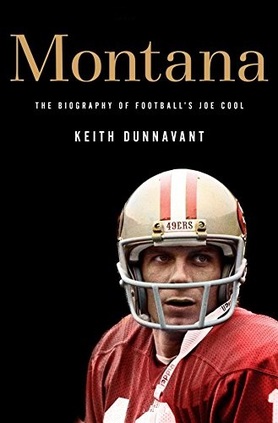
George Harrison was singing about his days with the Beatles all those years ago, but San Francisco 49ers fans can relate. They long for the days of cool — Joe Cool.
The days when Joe Montana was leading the 49ers to four Super Bowl titles — the NFL’s version of the Fab Four, if you will — are long gone, and the team is sitting in the NFC West cellar this season with a 3-6 record.
But San Francisco fans — and others who watched Montana play—will get a new perspective about the Hall of Fame quarterback thanks to Keith Dunnavant’s new biography.
“Montana: The Biography of Football’s Joe Cool” (Thomas Dunne Books; hardback; $26.99; 326 pages) is a brisk, focused look at a quarterback who remains the gold standard of signal-callers. Other quarterbacks had better passing statistics and better form, but few delivered as consistently in the clutch ass Montana.
The project spanned four years, and Dunnavant buttresses his narrative with research and lively interviews with friends, teammates, coaches and family members. That’s not surprising. Dunnavant’s books include biographies of Bart Starr (“America’s Quarterback” in 2011) and Bear Bryant (“Coach” in 1996), and “The Missing Ring,” (2006), which focused on the undefeated 1966 Alabama football team.
Dunnavant himself is a good story. As a 14-year-old, he talked his way into becoming the sports editor of a small weekly paper in Athens, Alabama. There must be something magical about towns named Athens; in Athens, Georgia, a 15-year-old named Edwin Pope became sports editor of the Banner-Herald in 1943. Pope later became the longtime sports editor at the Miami Herald.
Dunnavant went on to work at the National in 1981, and also wrote for Sport magazine and Adweek. He also founded four magazines and wrote for two decades about college football.
In “Montana,” readers will read about the familiar and legendary successes: “The Catch,” which rocketed the 49ers into their first Super Bowl; and the winning drive he engineered in Super Bowl XXIII to defeat the Cincinnati Bengals. Who else could look into the huddle, with 92 yards to cover and barely three minutes to play, and casually remark to nervous teammate Harris Barton, “Look! Isn’t that John Candy?”
That exchange is legendary and gets full throttle in “Montana.” But what sets this biography apart are Dunnavant’s tales of Montana’s early career and his running battles with his high school coach (Chuck Abramski) and college coach (Dan Devine), both who seemed unsure of their quarterback’s ability.
Even Bill Walsh, the 49ers coach who created the West Coast offense that Montana executed to perfection, sometimes seemed to lack confidence in his star.
But that’s what fueled Montana. He had a desire to take his doubters words and shove them back down their throats. He didn’t do it with talk; Montana produced on the field, and engineered some amazing comebacks in college and in the pros. He was a competitor in his own right, and he benefited from a tough, demanding father who guided his young career.
 Keith Dunnavant spent four years researching and writing "Montana."
Keith Dunnavant spent four years researching and writing "Montana." Dunnavant also deserves kudos in his narrative about Super Bowl XIX to note that Marino shifted to a no-huddle offense late in the first quarter. I’ve seen very few reports of that game that mentions that fact, and while it worked at first, San Francisco’s defense adjusted and made life miserable for Marino.
But the 49ers’ victory and Montana’s near-flawless day demonstrated what fueled him.
“Time after time, he had been doubted, dismissed as too ungifted, too small, too fragile, too inconsistent, too this, not enough that, to become a successful quarterback,” Dunnavant writes. “He always looked so calm and centered … but beneath the surface, he was a tenacious competitor with a burning desire to win who desperately wanted to be respected, pursuing not just championships but some larger validation.”
Even after establishing himself, a back injury and the presence of Steve Young waiting in the wings as an impatient backup quarterback kept Montana on edge. But it also spurred him to greater things.
“The arrival of Steve Young stirred something deep inside Montana, empowering him to churn resentment into determination,” Dunnavant writes. “The presence of a talented rival breathing down his neck, ready to step in at any moment, was just what he needed to propel him toward a whole new level.”
“Montana” ends on a wistful note, as Joe Cool is enshrined in Canton and finally mends fences with the high school football coach who had downplayed his talents for so many years. Dunnavant displays a nifty touch throughout this biography, weaving Montana’s personal successes and failures with his spectacular college and pro career.
It’s a refreshing look, and it will remind 49ers fans of when their franchise was truly fab.
 RSS Feed
RSS Feed
